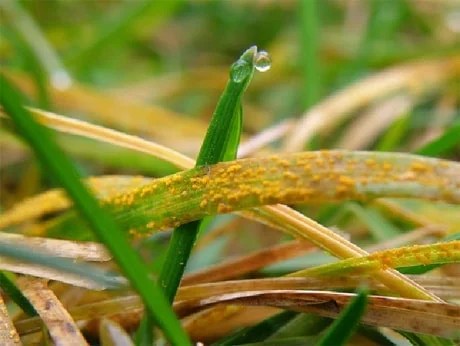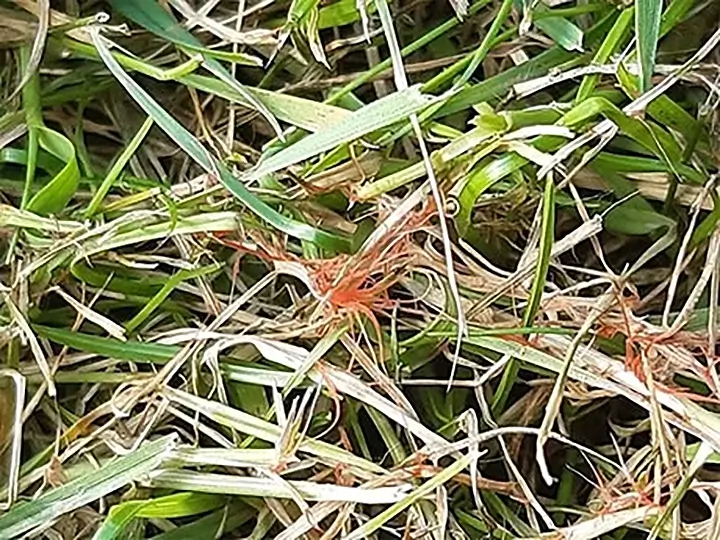Colours In Your Lawn
Last Updated: 16/05/2025
Changes of colour in turf can be common because different varieties of grass types reflect different colours. However, changes in turf colour may signify a lawn problem.
Lack of water and moisture in the turf is the main cause of colour change as the grass slowly starts to die. However, lawn diseases, insect problems, thatch build-up and compaction can also contribute to colour changes in a lawn. Whilst most changes in colour are harmless, some are signs of problems which should be addressed quickly to avoid further problems.
Common colours found in lawns
Green
The chlorophyll in leaves reflects green colours. The darker the green, the greater the amount of chlorophyll. Nitrogen, iron and magnesium are important in producing the deep green colour that you see in the leaves.
Yellow
Carotenoids are pigments that reflect yellow colours in leaves. These are present in the leaves all of the time, but you only see them when the turf is deficient of chlorophyll (lack of Nitrogen). It can also be that the plant is lacking in iron, magnesium or it could be suffering from a disease.
Brown
When your grass turns brown or straw coloured, it is normally dead. Individual blades of grass will die, and under certain conditions, the entire lawn may die in patches. A chemical spill, severe dog urine damage or drought can also cause grass to die. Therefore, it is always important to keep the grass watered in warm weather conditions.
Orange
Pigments that reflect orange light are generally not produced by the grass plant, but by fungi or disease elements. Rust diseases that attack grass leaves produce spores that are an orange-red colour, that you can rub off the leaf with your fingers. Rusts are pathogens that can kill the leaves of your turf, but in general they do not kill grass. They look unsightly, but the problem can be cured in a single application.
Red
Anthocyanins are natural pigments in leaves, and reflect red and blue colours. They are seen when either the chlorophyll content is low, or when they are produced in large quantities. When red is observed in turf, it means the grass is stressed. Please contact us for an analysis if this problem persists.
Pink
During the early stage of red thread disease, very fine red threads can be seen on the leaves, which give the disease its name. However, once it matures, it produces pink ‘candy floss’ type clumps that will produce spores. These can be spread by shoes, lawn mowers, water and other items moved around the grass. Red Thread does not kill grass as it affects the leaf, not the root, but left to develop it can cause significant damage.
Consider how problems have occurred
Has your lawn become yellow after it was last cut, or has it gradually turned yellow over a period of time?
Discolouration can disappear just as quickly as it first appeared. Closer examination may reveal what the problem is. Remember that grass is a living thing, therefore environmental conditions can have an effect on this.
Rust in Turf

This disease is caused by nutrient deficiencies and moisture stress. In late summer and into autumn, the disease becomes apparent as orange-red spores are produced.
Rusts can kill the leaves of grass, however this is quite rare. The disease can be controlled with a single treatment application. However, applying the correct feed nutrients is often enough to stop the disease from occurring.
Red Thread

Red Thread is a disease caused by a fungus that lives in turf. There are strains of this disease that can be resilient to most treatment applications.
Most turf has this fungus. Normally you don’t see it or the disease that it causes. However, during conditions of high humidity or wetness, it may start to appear. It is the most common and complained about lawn disease that we have in the UK as it looks unsightly.
When Red Thread starts to appear in your lawn, you may notice small patches of grass leaves turning brown and straw-like. However, if you take a piece of it out of the lawn and place it on a white piece of paper, you will actually see it is a reddish-pink colour.
Fortunately, Red Thread does not kill grass, it just looks unsightly and is much more common in fine fescue lawns than any other grass types in the UK. It is rarely seen in rye grass, which is another common type of grass found across the country.
If you think that your lawn has Red Thread, please contact us immediately for an application of fungicide, which is preventative and curative. We have products that can remove this quick spreading disease.
Written by Adam Newell, Lawn Care Operative & Lawn Master Franchise Owner
View Profile
Adam is a qualified turf professional with over 15 years of experience. Before joining Lawn Master, Adam worked as Deputy Head Greenkeeper at Malton & Norton Golf Club. Adam is based in Malton and offers lawn care services in North Yorkshire.




